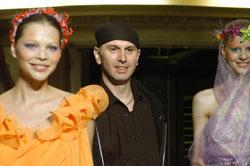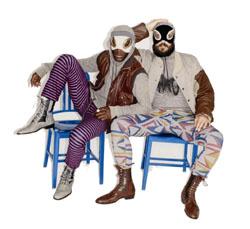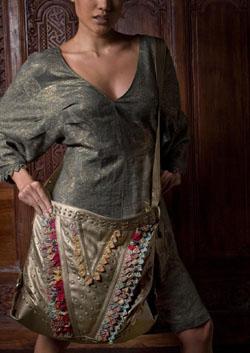Swedish "fast-fashion" chain H & M made a big splash when it opened in Ginza in September and the line just to get into the store continues to be 30-minutes long. The company has added to its brood with a new youth-oriented store in Harajuku, kicking it off with a collaboration with Japanese label Comme des Garcons.
On Nov. 8, the day of the store's opening, the CDG collection of polka-dot deconstructed men's and women's pieces was rolled out a whole week ahead of the rest of the world. CDG was one of the revolutionary avant-garde brands that swept over fashion in the 1980s and continues to hold cult status. (The collaboration unsurprisingly sold out after more than 1,500 fans lined up three days ahead of the rollout).
The CDG collection highlights the success high fashion can reap from fast fashion, a perfect fit for H&M, which is enjoying the rapt attention of consumers who once flocked to luxury brands. The only H&M/CDG pieces still available in Japan are to be found on online auctions, but part of H&M's main line was inspired by the collaboration and sports the store's incredibly reasonable prices. As H&M country manager Christine Edman says, "The Japanese consumer loves fashion, and we love to give them that within everyone's reach."
A new camp

Dresscamp has unveiled its first collection with new designer Marjan Pejoski at the helm. By bringing some much-needed glitz to an often somber Tokyo Collection Week, the brand has become a perennial Tokyo favorite. Not satisfied with having the celebs in just the front row, though, Dresscamp hired London-based star Pejoski to lead the label after original designer Toshikazu Iwaya left the brand to pursue personal projects earlier this year.
Famous for making the iconic swan dress worn by eccentric musician Bjork in 2001, Pejoski is the first Western designer to ever take the chief position at a Japanese brand. The new collection was inspired by shipwrecks and the Greek Sirens who lured sailors into temptation. Pejoski's vision led to a distinct dandyism in his menswear, with high-waisted sailor pants, silk jellyfish print robes and velvet embroidered slippers with chunky high heels. The women were dressed more outrageously, with trench coats made of transparent metallic netting, body suits and leggings doused in barnacle brocade. The massive platform shoes in which the models tromped down the aisle were surely meant as a metaphoric anchor to stop them from drowning in Dresscamp's sea of fashion debauchery.
In total, Pejoski's show offered the audience a fantasy island of cute femme sailors and the sexy, coy sea creatures who would be their concubines. The designer's — and the label's — fans will surely be boarding the next ship to sail there.
Westwood's men

Vivienne Westwood, along with Paul Smith, occupy an iconic position in the Japanese fashion world. Since Westwood's rise to fame in the 1970s and '80s, she's been revered by an obsessive group of fans in this country. Her Japanese empire continues to grow with the recent unveiling of her first-ever "men's only" boutique in Omotesando.
From her punk days to her obsession with tartan and an edgy, distinctly British style, Westwood's influence is as visible as ever in Japan. With shops up and down the country, news of her latest Tokyo men's flagship store confirms that the global credit crunch won't stop the Cheshire-born Queen of British fashion.
Filling a comfortable 102 sq. meters, the Vivienne Westwood Man shop fits in pretty much everything the style- conscious male would want from Westwood, with a full menswear collection, accessories (including the fall launch of her men's bag range) and unique one-off items special to the store.
The building itself is worth visiting just for the design alone. Inspired by the prehistoric monument Stonehenge, the store features worn gray tones, gray cement floors and silver handrails, adding a bit of mystic paganism to the streets of Omotesando.
Shibuya gets YellowChinami Kamishima has been a Tokyo fashion-circuit mainstay since her eponymous label launched in 2002. Rather than uprooting to Tokyo, though, the Hokkaido native has kept her atelier in Sapporo, where she uses the natural resources of the island in her collections. Kamishima's fall/winter line included silky-soft microfiber tops dyed with natural Hokkaido water and a coat made of recycled lamb's wool.
Four seasons ago, Kamishima launched Kamishima Chinami Yellow, an offshoot line that tones down the glamour but cranks up the pep. Yellow features comfy one-piece dresses and simple blouses printed with darling doodles and embellished with watercolors and embroidery. These sketches and prints are the line's raison d'e^tre, conjuring the designer's playful, hidden world.
The first Kamishima Chinami Yellow shop opened in Shibuya Parco in September. The current fall collection available there, titled "Wonderland," presents a picture-book world with organic swirls and twisting, curved and straight lines, similar to the aesthetic consistently seen in Chinami's fun designs.
Idealism in the bag

Mixing fashionable accessories, recycled material and charitable causes is just a normal day for the ambitious Dialog team. Based in Hong Kong, Cassandra Postema and Dong Shing Chiu are graduates of London's Central Saint Martins College of Art and Design who make colorful and kitschy handbags, jewelry and purses for environmentally and socially aware women.
Dialog is upfront about its involvement in politics and charity. Postema and Chiu are currently participating in the "hopetees" project, which produces limited addition T-shirts to raise funds for worthy causes in Asia. And when the duo started buying locally recycled cloth from workers in Asia, it led to the establishment of fair-trade schemes and a wide network of programs, including sewing schools in Vietnam and future plans for a weaving project in Thailand.
Available for the first time in Japan, at a range of stores including Red Rubber Ball in La Foret Harujuku and Ku Croissant locations in Tokyo and Osaka, Dialog bags are easily recognizable for their fourfold origamilike trim made from recycled fabric. The collection features an unorthodox array of vibrant colors, from ox blood to moss green to faded canary yellow.





